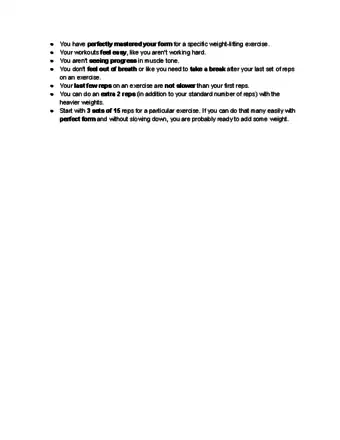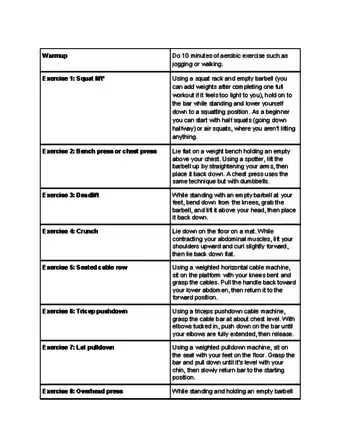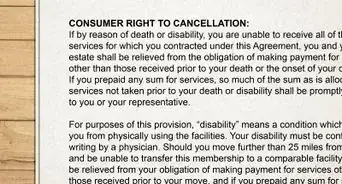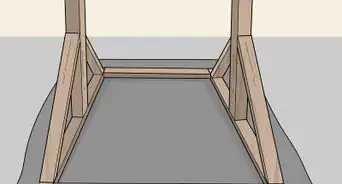This article was co-authored by Laila Ajani and by wikiHow staff writer, Amy Bobinger. Laila Ajani is a Fitness Trainer and founder of Push Personal Fitness, a personal training organization based in the San Francisco Bay Area. Laila has expertise in competitive athletics (gymnastics, powerlifting, and tennis), personal training, distance running, and Olympic lifting. Laila is certified by the National Strength & Conditioning Association (NSCA), USA Powerlifting (USAPL), and she is a Corrective Exercise Specialist (CES).
There are 8 references cited in this article, which can be found at the bottom of the page.
This article has been viewed 207,875 times.
Weight training is a great way to build muscle and get into shape, but it usually requires a gradual progression to heavier weights to see the best results. Everyone's body and fitness goals are different, so there's no set answer for when and how to increase the weight you're using. However, if you can easily finish your reps and you have good form, it might be time to move up to the next size weight!
Steps
Getting in Shape to Lift
-
1Eat a diet that's high in lean protein and veggies and low in carbs. Think of the food you put into your body as fuel for your activity. The cleaner the fuel, the more efficiently your body will run. Avoid foods that are high in sugars and that lack nutrients. Opt for lean proteins like grilled chicken or seafood, and try to fill about half of your plate with colorful veggies, like leafy greens, sweet potatoes, or broccoli.
- Don’t eat for 30 minutes before you exercise to avoid cramps.
-
2Run, jog, or swim for at least 150 minutes a week. To start getting in great physical shape before you lift, you should try to aim for at least 150 minutes of moderate aerobic exercise each week. Running, jogging, and swimming are some of the most popular aerobic exercises, but feel free to get creative — a flag football game with friends or taking the stairs at work can count towards your goal.[1]Advertisement
-
3Study the major muscle groups. As you start getting ready to lift weights, study anatomy charts and workout guides online to learn more about the body's major muscle groups. Pay attention to how each set of muscles moves to control your body, then mimic those movements during weight training. Understanding how the muscles work will help you have a better understanding of what you're working towards. [2]
- If you know that the muscles biceps, rhomboids, latissimus dorsi, and posterior deltoids all contract and shorten to move the shoulder and arm, you will understand the exact benefit you get from doing a lateral pull-down.
-
4Practice bodyweight exercises to prepare your muscles for lifting weights. Bodyweight exercises don't require any equipment to give you a good workout — just the weight of your own body and gravity is enough to help you build muscles. Bodyweight exercises like squats, push-ups, and sit ups are a great way to get your body in shape for weight lifting.
-
5Start with lifting smaller weights, then work your way up. You might have images of pressing some heavy iron to build huge muscles, but you can actually get benefits by lifting lighter weights for more reps, plus you decrease your risk of injury. Start out by selecting a weight that you can easily lift 8-12 times, then gradually work your way up to heavier weights.[3]
-
6Make sure your form is correct before you lift more weight. You might not notice that your form is off when you're lifting lighter weights, but if your knees aren't aligned properly, or your back isn't straight, it can make a big difference when you add more weight to your lift. If you go to a gym, ask a trainer to evaluate your form before you increase your lifts.[4]
- If you don't go to a gym, watch video tutorials and work out in front of a mirror or film yourself lifting weights to check your form. Pay special attention to any aches or pains you feel while lifting.
Adding More Weight
-
1Add more weight on a day that you feel good. If you’re feeling tired or sore, adding more weight could leave you especially vulnerable to injury. Instead, wait for a day when you feel strong and energetic.[5]
-
2Do a warm-up before you start lifting. A proper warm-up will increase the oxygen in your bloodstream and your muscles, helping reduce the risk of injury and helping prevent or relieve muscle soreness. Before you lift, try 5-10 minutes of light cardio activity, like push-ups, sit-ups, jogging on a treadmill, or riding a stationary bike.[6]
-
3Add a little weight at a time. Adding too much weight too fast can cause you to injure yourself. You should increase the weight by no more than 10 percent at a time to your routine to ensure your body stays challenged.[7]
-
4Lift heavy weights for compound exercises. Compound lifts, like squats, deadlifts, and lunges, are great for working multiple muscle groups at once. Use heavier weights for these exercises.[8]
-
5Exercise with about 10% less than the maximum you can lift. Don’t strain your body by lifting the absolute most you can every time. This will increase your risk of injury and can lead your body to plateau. Dial it back to about 90% of the most you can lift, then increase a little every 2-4 weeks.[9]
-
6Increase your rest time between sets when you lift more weight. Give your body time to recover between sets when you increase your weights. If you normally rest 30-45 seconds between sets, try resting for 60-90 seconds instead. You may need to rest longer if you are performing compound exercises and lifting 90 percent of your maximum weight.
-
7Make a schedule and balance your workout. Make sure you are alternating your exercises to ensure you equally balance all of your muscle groups. Think about training your pushing and pulling muscles (like your hamstrings vs your quads) equally, as well as balancing your arms, legs, chest, and back. Set up a schedule so you know what muscle group you’ll focus on each day.[10]
Weightlifting Tips and Schedules
Expert Q&A
Did you know you can get expert answers for this article?
Unlock expert answers by supporting wikiHow
-
QuestionDoes holding weights build muscle?
 Laila AjaniLaila Ajani is a Fitness Trainer and founder of Push Personal Fitness, a personal training organization based in the San Francisco Bay Area. Laila has expertise in competitive athletics (gymnastics, powerlifting, and tennis), personal training, distance running, and Olympic lifting. Laila is certified by the National Strength & Conditioning Association (NSCA), USA Powerlifting (USAPL), and she is a Corrective Exercise Specialist (CES).
Laila AjaniLaila Ajani is a Fitness Trainer and founder of Push Personal Fitness, a personal training organization based in the San Francisco Bay Area. Laila has expertise in competitive athletics (gymnastics, powerlifting, and tennis), personal training, distance running, and Olympic lifting. Laila is certified by the National Strength & Conditioning Association (NSCA), USA Powerlifting (USAPL), and she is a Corrective Exercise Specialist (CES).
Fitness Trainer
-
QuestionHow can I lift stronger and heavier weights?
 Laila AjaniLaila Ajani is a Fitness Trainer and founder of Push Personal Fitness, a personal training organization based in the San Francisco Bay Area. Laila has expertise in competitive athletics (gymnastics, powerlifting, and tennis), personal training, distance running, and Olympic lifting. Laila is certified by the National Strength & Conditioning Association (NSCA), USA Powerlifting (USAPL), and she is a Corrective Exercise Specialist (CES).
Laila AjaniLaila Ajani is a Fitness Trainer and founder of Push Personal Fitness, a personal training organization based in the San Francisco Bay Area. Laila has expertise in competitive athletics (gymnastics, powerlifting, and tennis), personal training, distance running, and Olympic lifting. Laila is certified by the National Strength & Conditioning Association (NSCA), USA Powerlifting (USAPL), and she is a Corrective Exercise Specialist (CES).
Fitness Trainer Add more weight as soon as you can lift the previous weight without struggling. When you're first beginning, you can move up very easily with almost every single session. For instance, if you're able to complete 3 sets of 10 lifts at a certain weight, you might move up to a higher weight on your next workout, but if the last lift is very slow, you might stay with that weight a little longer.
Add more weight as soon as you can lift the previous weight without struggling. When you're first beginning, you can move up very easily with almost every single session. For instance, if you're able to complete 3 sets of 10 lifts at a certain weight, you might move up to a higher weight on your next workout, but if the last lift is very slow, you might stay with that weight a little longer. -
QuestionI can currently only lift 45 lbs, is it possible to go up to 200 lbs in a year?
 Arthur ParxCommunity AnswerIf you are dedicated to your workout sessions, gradually you will be able to lift greater weights, and yes, you can lift 200 lbs within a year. Bodybuilding is not something that happens overnight. It takes a lot of hard work and consistency. Keep on pumping your body and eventually you will get there.
Arthur ParxCommunity AnswerIf you are dedicated to your workout sessions, gradually you will be able to lift greater weights, and yes, you can lift 200 lbs within a year. Bodybuilding is not something that happens overnight. It takes a lot of hard work and consistency. Keep on pumping your body and eventually you will get there.
References
- ↑ https://www.mayoclinic.org/healthy-lifestyle/fitness/expert-answers/exercise/faq-20057916
- ↑ https://www.medicinenet.com/how_muscles_work_and_respond_to_resistance_exercise/views.htm
- ↑ https://www.mensfitness.com/training/build-muscle/if-you-want-build-muscle-and-gain-strength-lift-lighter-weights-more-reps
- ↑ https://www.self.com/story/why-its-totally-ok-to-use-light-weights
- ↑ https://www.self.com/story/weight-lifting-increase
- ↑ https://www.webmd.com/fitness-exercise/features/warming-up-cooling-down
- ↑ https://www.mensfitness.com/training/build-muscle/10-strength-building-strategies
- ↑ https://www.womenshealthmag.com/fitness/strength-training-lifting-heavy-weights
- ↑ https://www.mensfitness.com/training/build-muscle/10-strength-building-strategies
About This Article
To lift heavier weights, start small and gradually work your way up so you don't hurt yourself. Also, make sure that you're using the correct form before moving on to heavier weights. Start by using weights that you can comfortably lift at least 8 times. Then, increase the weight every 2-4 weeks by no more than 10 percent at a time. Try to lift with 10 percent less than the maximum you can handle, which will prevent you from plateauing. For more tips from our Personal Trainer co-author, like how to eat healthy to improve your gains, read on!





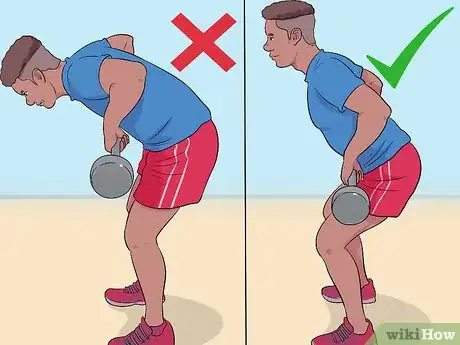


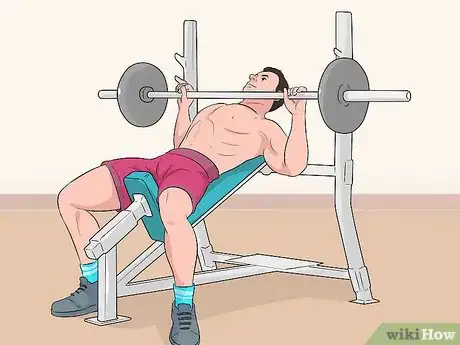
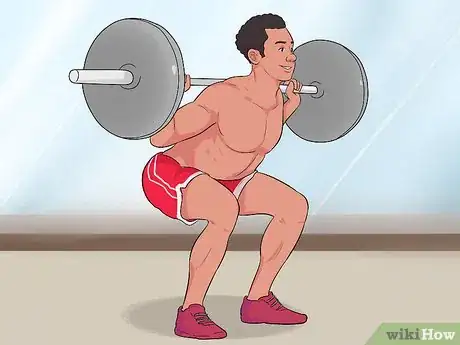

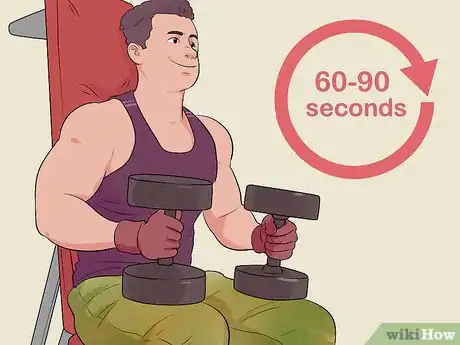
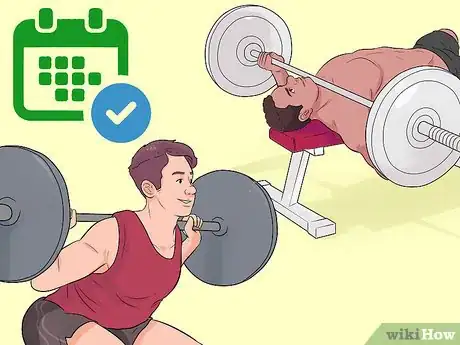
_sample.webp)
